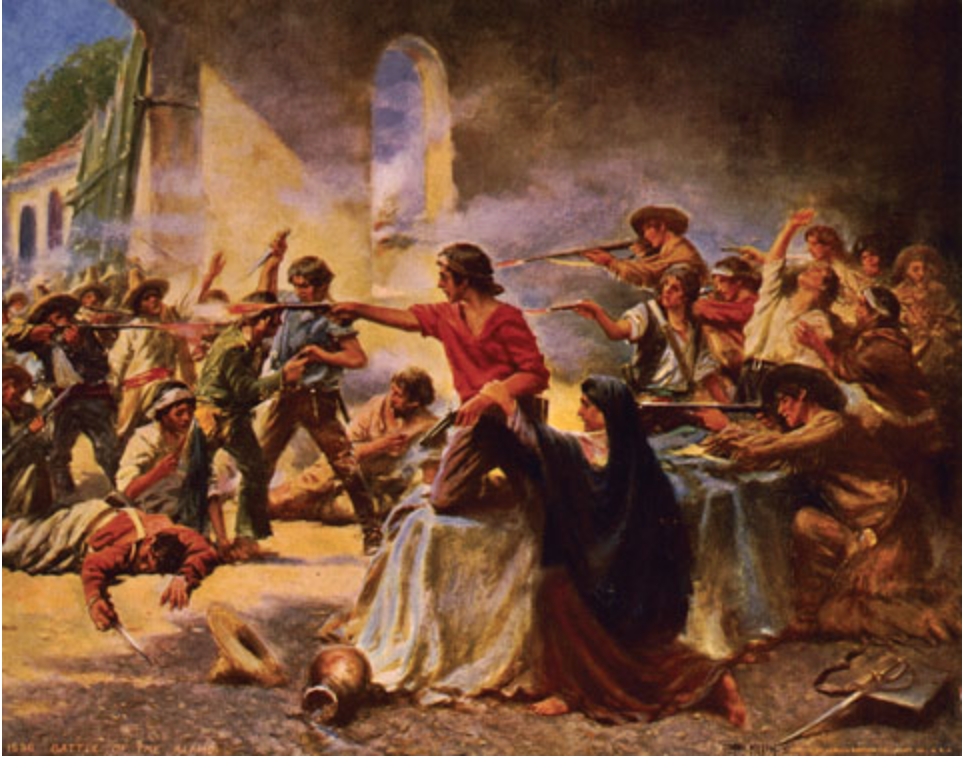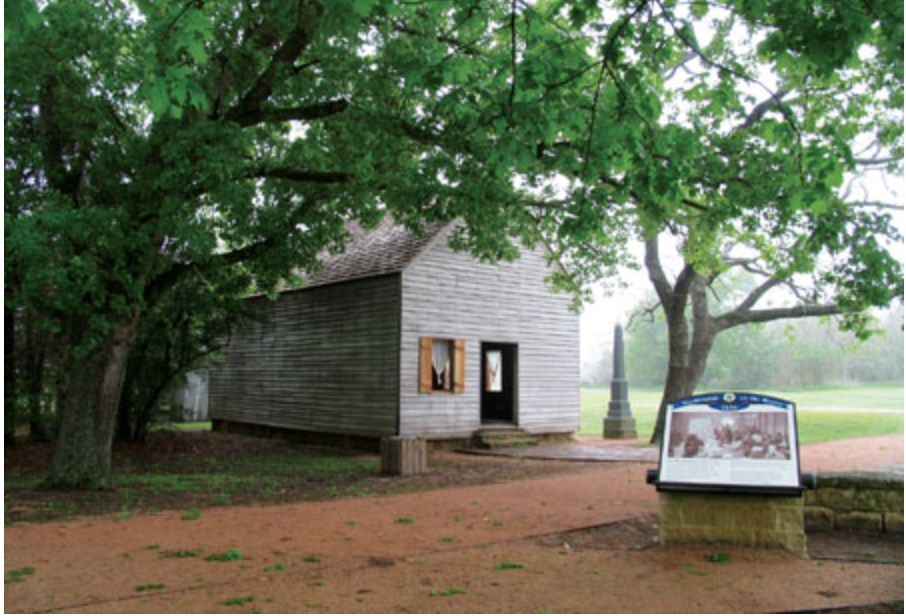Winning Independence
As 1836 opened, Texans felt in control of their destiny and secure in their land and their liberties. The Mexican army had been driven from their soil.
But tragedy loomed. Easy victories over government forces at Anahuac, Nacogdoches, Goliad, Gonzales and San Antonio in the fall of 1835 had given them a false sense of security. That independent mood was their undoing, for no government worthy of the name coordinated the defense of Texas. Consequently, as the Mexican counterattack developed, no one was in charge. Sam Houston was titular commander-in-chief of the Texas forces, but he had little authority.
Some even thought the Mexicans would not try to re-enter Texas. Few Texans counted on the energy and determination of Santa Anna, the dictator of Mexico.
The status of the strongholds along the San Antonio River was of concern to Houston. In mid-January, Houston sent James Bowie to San Antonio to determine if the Alamo was defensible. If not, Bowie had orders to destroy it and withdraw the men and artillery to Gonzales and Copano.
On Feb. 8, David Crockett of Tennessee, bringing 12 men with him, arrived to aid the revolutionaries.
On Feb. 12, 1836, Santa Annas main force crossed the Rio Grande headed for San Antonio. The Mexican battle plan had been debated. But Mexico's national pride was bruised by the series of defeats the nations army had suffered in 1835, capped by Gen. Coss ouster from San Antonio in December.
On Feb. 11, the Consultation's governor of the government Henry Smith, sent William B. Travis to San Antonio. Immediately a split in command at the Alamo garrison arose. Most were American volunteers who looked to the Houston-appointed Bowie as their leader. Travis had only a handful of Texas army regulars. Bowie and Travis agreed to share the command of 150 men.
Arriving at the Alamo on Feb. 23, Santa Anna left no doubt regarding his attitude toward the defenders. He hoisted a blood-red flag, the traditional Mexican symbol of no quarter, no surrender, no mercy. Travis and Bowie defiantly answered the display with a cannon shot.
Immediately the Mexicans began surrounding the Alamo and bombarding it. Throughout the first night and nights to come, Santa Anna kept up a continual din to destroy the defenders morale.
On Feb. 24, Bowie became ill and relinquished his share of command to Travis. Although the Mexican bombardment of the Alamo continued, none of the defenders was killed. In fact, they conducted several successful forays outside the fortress to burn buildings that were providing cover for the Mexican gunners and to gather firewood.
Messengers also successfully moved through the Mexican lines at will, and 32 reinforcements from Gonzales made it into the Alamo without a loss on March 1.
Historians disagree over which flag flew over the defenders of the Alamo.
Mexican sources have said that Santa Anna was outraged when he saw flying over the fortress a Mexican tricolor, identical to the ones carried by his troops except with the numbers 1 8 2 4 emblazoned upon it. Some Texas historians have accepted this version because the defenders of the Alamo could not have known that Texas independence had been declared on March 2 (see photo below). To the knowledge of the Alamos defenders, the last official position taken by Texas was in support of the Constitution of 1824, which the flag symbolized. But the only flag found after the battle, according to historian Walter Lord, was one flown by the New Orleans Greys.
By March 5, Santa Anna had 4,000 men in camp, a force he felt sufficient to subdue the Alamo.
Historians disagree on the date, but the story goes that on March 3 or 5, Travis called his command together and explained the bleak outlook. He then asked those willing to die for freedom to stay and fight; those not willing could try to get through enemy lines to safety. Even the sick Jim Bowie vowed to stay. Only Louis (Moses) Rose, a veteran of Napoleon's retreat from Moscow slipped out of the Alamo that night.
At dawn March 6, Santa Anna's forces attacked. When the fighting stopped between 8:30 and 9 a.m., all the defenders were dead. Only a few women, children and black slaves survived the assault. Davy Crockett's fate is still debated. Mexican officer Enrique de la Peña held that Crockett was captured with a few other defenders and was executed by Santa Anna.
Santa Anna's victory came at the cost of almost one-third his forces killed or wounded. Their deaths in such number set back Santa Annas timetable. The fall of the Alamo also brutally shook Texans out of their lethargy.
Sam Houston, finally given command of the entire Texas army, left the convention at Washington-on-the-Brazos on the day of the fall of the Alamo.
On March 11, he arrived at Gonzales to begin organizing the troops. Two days later, Susanna Dickinson, the wife of one of the victims of the Alamo, and two slaves arrived at Houston's position at Gonzales with the news of the fall of the San Antonio fortress.
Houston then ordered James Fannin to abandon the old presidio La Bahía at Goliad and to retreat to Victoria. Fannin had arrived at the fort in late January with more than 400 men. As a former West Pointer, he had a background in military planning, but Fannin had refused Travis pleas for help, and after receiving Houston's orders, Fannin waited for scouting parties to return.
Finally, on March 19, he left, but too late. Forward elements of Gen. José de Urreas troops caught Fannin's command on an open prairie. After a brief skirmish Fannin surrendered.
Santa Anna was furious when Gen. Urrea appealed for clemency for the captives. The Mexican leader issued orders for their execution. On March 27, a Palm Sunday, most of the prisoners were divided into groups and marched out of Goliad, thinking they were being transferred to other facilities. When the executions began, many escaped. But about 350 were killed.
On March 17, Houston reached the Colorado near the present city of La Grange and began receiving reinforcements. Within a week, the small force of several hundred had become almost respectable, with 1,200–1,400 men in camp.
By the time Houston reached the Colorado, the convention at Washington-on-the-Brazos was completing work. David Burnet, a New Jersey native, was named interim president of the new Texas government, and Lorenzo de Zavala, a Yucatán native, was named vice president.
On March 27, Houston moved his men to San Felipe on the Brazos. The Texas army was impatient for a fight, and there was talk in the ranks that, if action did not develop soon, a new commander should be elected.
As the army marched farther back toward the San Jacinto River, two Mexican couriers were captured and gave Houston the information he had hoped for. Santa Anna in his haste had led the small Mexican force in front of Houston. Now the Texans had an opportunity to win the war.
Throughout the revolt, Houston's intelligence system had operated efficiently. Scouts, commanded by Erastus Deaf Smith, kept the Texans informed of Mexican troop movements. Hendrick Arnold, a free black, was a valuable spy, posing as a runaway slave to enter Mexican camps to gain information.
Early on April 21, Gen. Cos reinforced Santa Annas troops with more than 500 men. The new arrivals, who had marched all night, disrupted the camps routine for a time, but soon all the soldiers and officers settled down for a midday rest.
About 3 p.m., Houston ordered his men to parade and the battle was launched at 4:30 p.m.
A company of Mexican-Texans, commanded by Juan Seguín, had served as the rear guard for Houstons army through much of the retreat across Texas and had fought many skirmishes with the Mexican army in the process.
Perhaps fearing the Mexican-Texans would be mistaken for Santa Annas soldiers, Houston had assigned the company to guard duty as the battle approached. But after the men protested, they fought in the battle of San Jacinto.
Historians disagree widely on the number of troops on each side. Houston probably had about 900 while Santa Anna had between 1,100 and 1,300.
But the Texans had the decided psychological advantage. Two thirds of the fledging Republic's army were old Texans who had family and land to defend. They had an investment of years of toil in building their homes. And they were eager to avenge the massacre of men at the Alamo and Goliad.
In less than 20 minutes they set the Mexican army to rout. More than 600 Mexicans were killed and hundreds more wounded or captured. Only nine of the Texans died in the fight.
It was not until the following day that Santa Anna was captured. One Texan noticed that a grubby soldier his patrol found in the high grass had a silk shirt under his filthy jacket. Although denying he was an officer, he was taken back to camp, where he was acknowledged with cries of El Presidente by other prisoners.
Santa Anna introduced himself when taken to the wounded Houston.
President Burnet took charge of Santa Anna, and on May 14 the dictator signed two treaties at Velasco, a public document and a secret one. The public agreement declared that hostilities would cease, that the Mexican army would withdraw to south of the Rio Grande, that prisoners would be released and that Santa Anna would be shipped to Veracruz as soon as possible.
In the secret treaty, Santa Anna agreed to recognize Texas independence, to give diplomatic recognition, to negotiate a commercial treaty and to set the Rio Grande as the new Republic's boundary.
. . . Page 1 2 3
— This multi-part narrative of Texas' past, from prehistoric times to 1980, is based on "A Concise History of Texas" by former Texas Almanac editor Mike Kingston. Mr. Kingston's history was published in the 1986–1987 edition of the Texas Almanac, which marked Texas' sesquicentennial. Robert Plocheck, associate editor of the Texas Almanac, edited and expanded Mr. Kingston's history.



